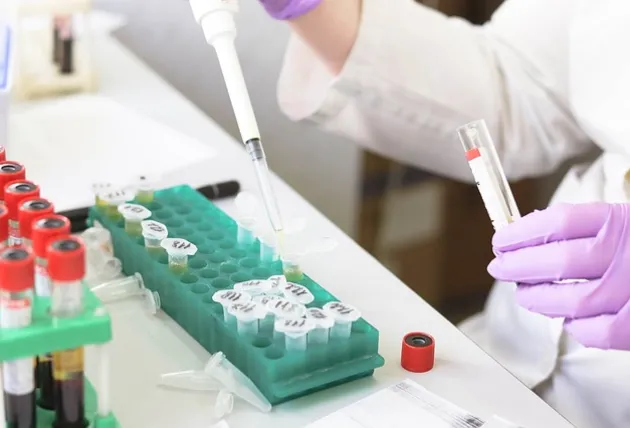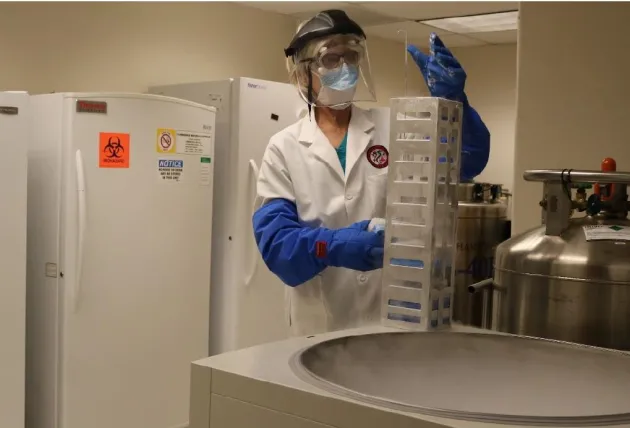Biospecimen Repository
The Veterinary Biospecimen Repository is a collection of samples from dogs and cats with cancer as well as healthy animal controls. Samples are stored under controlled conditions for future use by multiple investigators. Following established collection guidelines for sample collection and processing, tissues are collected and archived only after receiving consent from the owners.
The Veterinary Biospecimen Repository represents a remarkable resource that continues to assist investigators as they strive to develop new detection and treatment strategies for both animals and people.

The current collection contains samples from more than 1800 animals and 70 different tumor types. Samples from the OSU-VBR have been used in collaborative research involving investigators at Nationwide Children's Hospital, Ohio State's Wexner Medical Center, College of Pharmacy, and College of Engineering, as well as veterinary and human biomedical industry researchers and nonprofit research institutes across the country.
These collaborations have led to the discovery of common markers, mutations, and genetic pathways in osteosarcoma, pulmonary adenocarcinoma, lymphoma, colorectal, prostate and breast cancer. They have also been used in studies of bone and lung metastasis.
The OSU-VBR collaborates with the Clinical and Translational Science Award One Health Alliance (COHA), to advance our understanding of diseases shared by humans and animals. The alliance leverages the expertise of physicians, research scientists, veterinarians, and other professionals to find solutions for medical problems and to address the well-being of humans, animals, and the environment.
Benefits
The Ohio State University Veterinary Biospecimen Repository (OSU-VBR) is one of the most extensive collections of canine and feline tumors in the United States. Serving as an invaluable resource for pre-clinical cancer research, the OSU-VBR maintains an inventory of fully clinically annotated tissue samples from veterinary patients with spontaneous cancers. This large repository of naive tumor tissue samples, often paired with normal samples available, enhances translational research by accelerating preliminary research on potential disease markers and targets of therapeutic agents.
Samples collected from canine tumors can be used in place of human tissue in preliminary research. This significantly reduces the cost of preliminary research, preserving rare and valuable human tissue for later research, while eliciting important information about canine cancer in the process.
The benefits of using the Biospecimen Repository include:
- Collection, annotation, storage, and dissemination of high-quality biological material for research.
- Many companion animal diseases are similar in biology and behavior to human diseases, making them an excellent research model for human disease.
- Dogs and cats are exposed to the same environmental risk factors as humans, so studying their cancers may provide clues about what causes cancer in people.
- Specimens can be used by clinicians, molecular biologists, geneticists, and epidemiologists to conduct research that will improve the lives of both animals and humans.
- As more investigators see the value of spontaneous disease models in client-owned animals, additional exciting collaborations can be formed to study diseases other than cancer.

Collection and Processing
All samples are collected from client owned animals after obtaining informed consent from owners. Urine and blood are collected prior to surgery or euthanasia. Tissue samples are collected from tissue that is removed during surgery or immediately following euthanasia. All samples are processed immediatey following collection.
Body fluids are frozen in cryovials at -80oC and stored in vapor phase liquid nitrogen as:
- Whole Blood: 0.5-1.0ml aliquots
- Serum: 0.5ml aliquots
- Plasma: 0.5ml aliquots
- All-cell pellet
- Urine: 0.5ml aliquots
Tumor and normal tissue are processed and stored as:
- Flash frozen aliquots stored in vapor phase liquid nitrogen (100-200 mg)
- Optimal cutting temperature compound (OCT) frozen blocks containing 1-4 small (<100mg) samples stored at -80oC
- Formalin-fixed paraffin-embedded blocks containing sections that are repesentative of the frozen samples. These blocks are stored in files at room temperature.
Contact Information
CVM-VetMedBiospecimenRepository@osu.edu
Veterinary Medical Center
601 Vernon L. Tharp Street
Columbus, OH 43210
Publications
The following is a list of publications made possible thanks to sample collections through the Biospecimen Repository.
- Characterization of STAT3 activation and expression in canine and human osteosarcoma.
- Oncostatin M promotes STAT3 activation, VEGF production, and invasion in osteosarcoma cell lines.
- Overexpression of miR-9 in mast cells is associated with invasive behavior and spontaneous metastasis.
- MiR-9 is overexpressed in spontaneous canine osteosarcoma and promotes a metastatic phenotype including invasion and migration in osteoblasts and osteosarcoma cell lines
- Abstract 540. Characterization of miR-9 expression and activation in canine osteosarcoma
- Abstract 4825: Common genetic pathways are involved in canine diffuse large B cell lymphoma relapse and human diffuse large B cell lymphoma lympomagenesis
- Abstract 1143: Deep sequencing of microRNAs in canine diffuse large B-dell lymphoma
- Met interacts with EGFR and Ron in canine osteosarcoma
- Evaluation of expression and function of vascular endothelial growth factor receptor 2, platelet derived growth factor receptors-alpha and -beta, KIT, and RET in canine apocrine gland anal sac adenocarcinoma and thyroid carcinoma
- Characterization of canine osteosarcoma by array comparative genomic hybridization and RT-qPCR: signatures of genomic imbalance in canine osteosarcoma parallel the human counterpart.
- Genome-wide analyses implicate 33 loci in heritable dog osteosarcoma, including regulatory variants near CDKN2A/B
- Genome-Wide Association Study of Golden Retrievers Identifies Germ-Line Risk Factors Predisposing to Mast Cell Tumours
- Canine prostate cancer cell line (Probasco) produces osteoblastic metastases in vivo.
- Animal Models of Bone Metastasis.
- Abstract 184: Breed Associated miRNA Expression in Canine Osteosarcoma
- Markers of iron metabolism in retired racing Greyhounds with and without osteosarcoma.
- Feline Mammary Cancer
- Canine pulmonary adenocarcinoma tyrosine kinase receptor expression and phosphorylation
- A clinically relevant mouse model of canine osteosarcoma with spontaneous metastasis
- miR-29 acts as a decoy in sarcomas to protect the tumor suppressor A20 mRNA from degradation by HuR